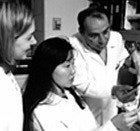Robust life sciences activity has always been a distinctive and pivotal component of the academic agenda at the Harvard School of Public Health (HSPH). As a result, major scientific discoveries have consistently emerged from the School’s laboratory benches.
There are many reasons why life sciences have been central at HSPH. First, biomedical studies, when combined with epidemiological, social, behavioral, and policy research, create a multidimensional picture of disease—one that spans the gene to the globe. Such rigorous research also uncovers the fundamental mechanisms of disease, including how environmental exposures—from chemical pollutants and infectious agents to dietary fat and pharmaceutical therapies—shape biological processes.
Yet while life sciences research enriches public health, public health also enriches the life sciences, by creating the kind of “mission-oriented” research that addresses some of the most profound problems facing humankind.
From its founding, the School has nurtured this type of expansive, visionary science. For example, Thomas Weller, head of the Department of Tropical Public Health from 1954 to 1981, chose to focus on a devastating scourge: polio. His Nobel Prize-winning work, with John Enders and Frederick Robbins, on how to grow poliomyelitis viruses in culture paved the way for others to develop the polio vaccine, and later other vaccines.
Today, HSPH is carrying on the life sciences tradition. It is helping propel the growing study of how genes and environmental forces interact to cause disease—from diabetes to asthma to the afflictions of aging. Over the next few years, activities in this field will tie laboratory discoveries to public policy, an area I think of as “public health genomics.” My far-seeing predecessor, Dean Barry R. Bloom, launched the School’s Genes and Environment Initiative—an endeavor on which I intend to build.
This issue of the Review describes some of our current efforts in exploring gene-environment interactions. Elsewhere in this issue, you will read about the inspiring commitment of HSPH alum Karen Anderson, who has drawn on decades of work improving health in Chile’s shantytowns to make a meaningful contribution to that nation’s earthquake relief efforts this year. And you will read about how the School’s students are helping construct, from the ground up, a public health system on Africa’s isolated Idjwi island.
The Spring/Summer 2010 issue of the Review examined another key focus at the School: women and health. The Winter 2010 issue looked at a third priority: comparative effectiveness research. As these diverse initiatives suggest, public health challenges always arise at the crossroads of the social, the behavioral, and the biological: the fertile ground from which solutions spring.
— Julio Frenk is Dean of the Faculty and T & G Angelopoulos Professor of Public Health and International Development, Harvard School of Public Health
